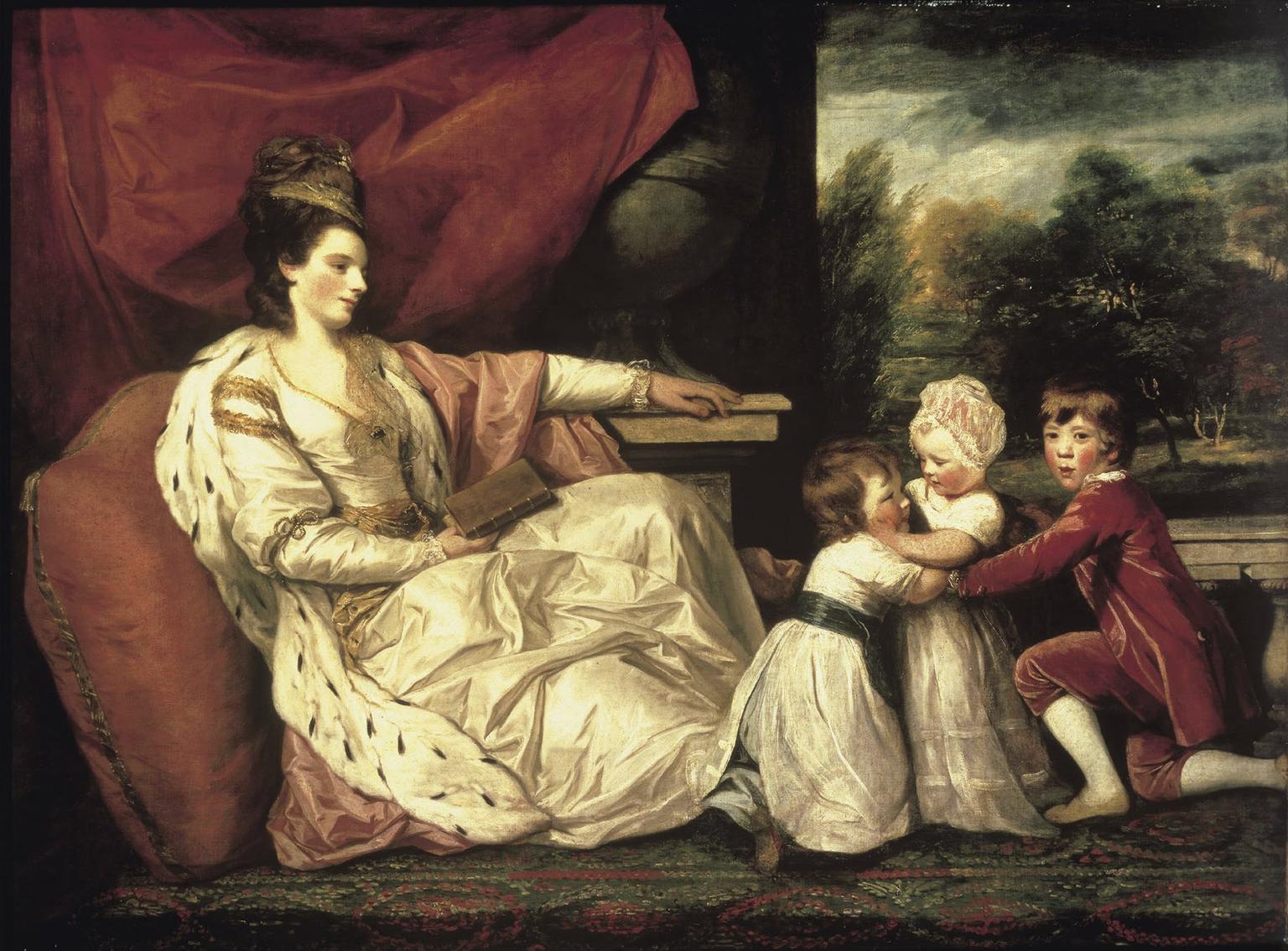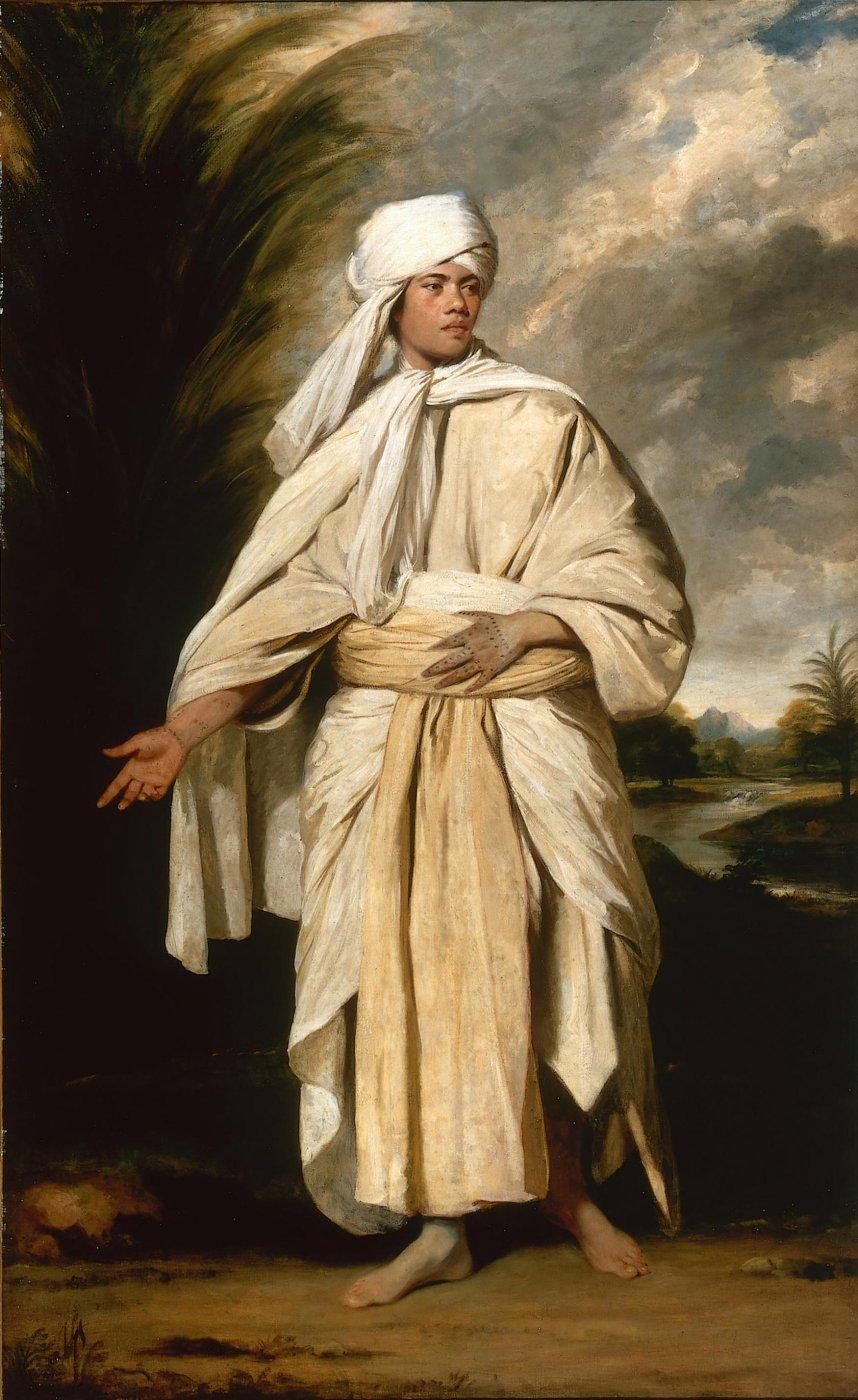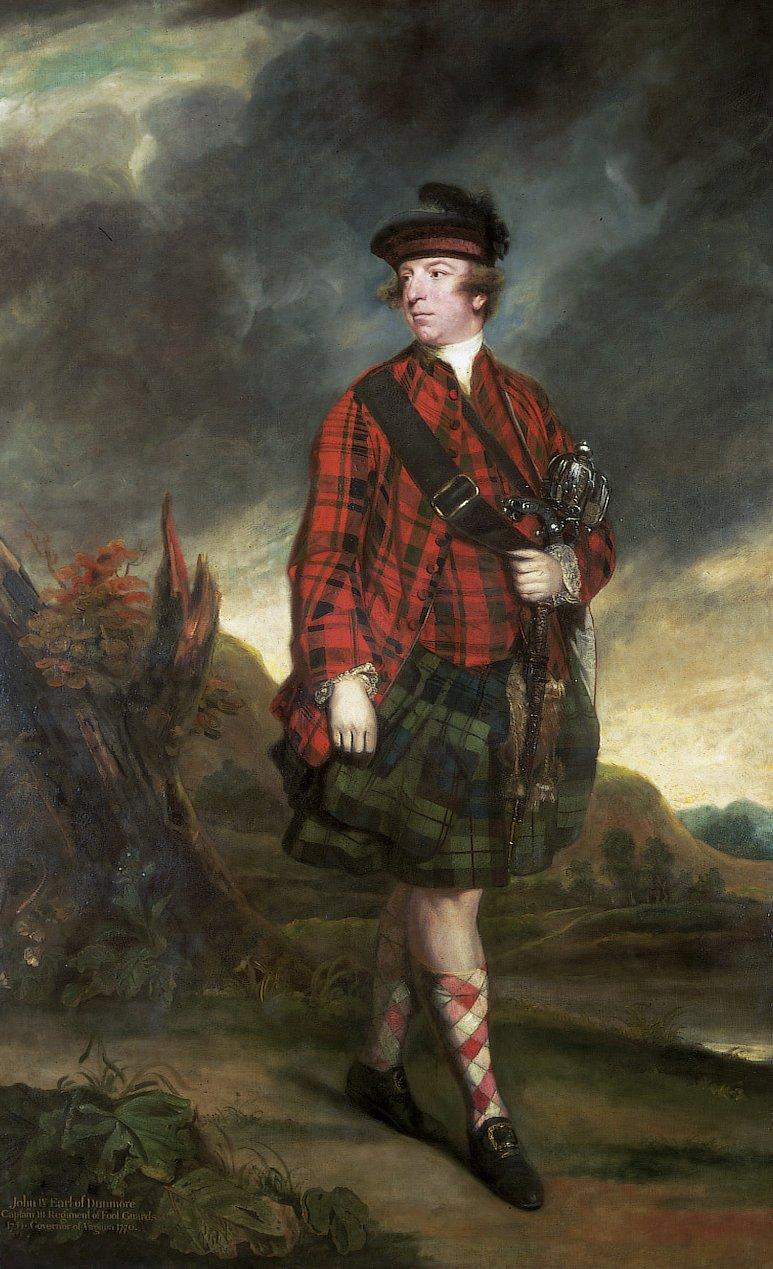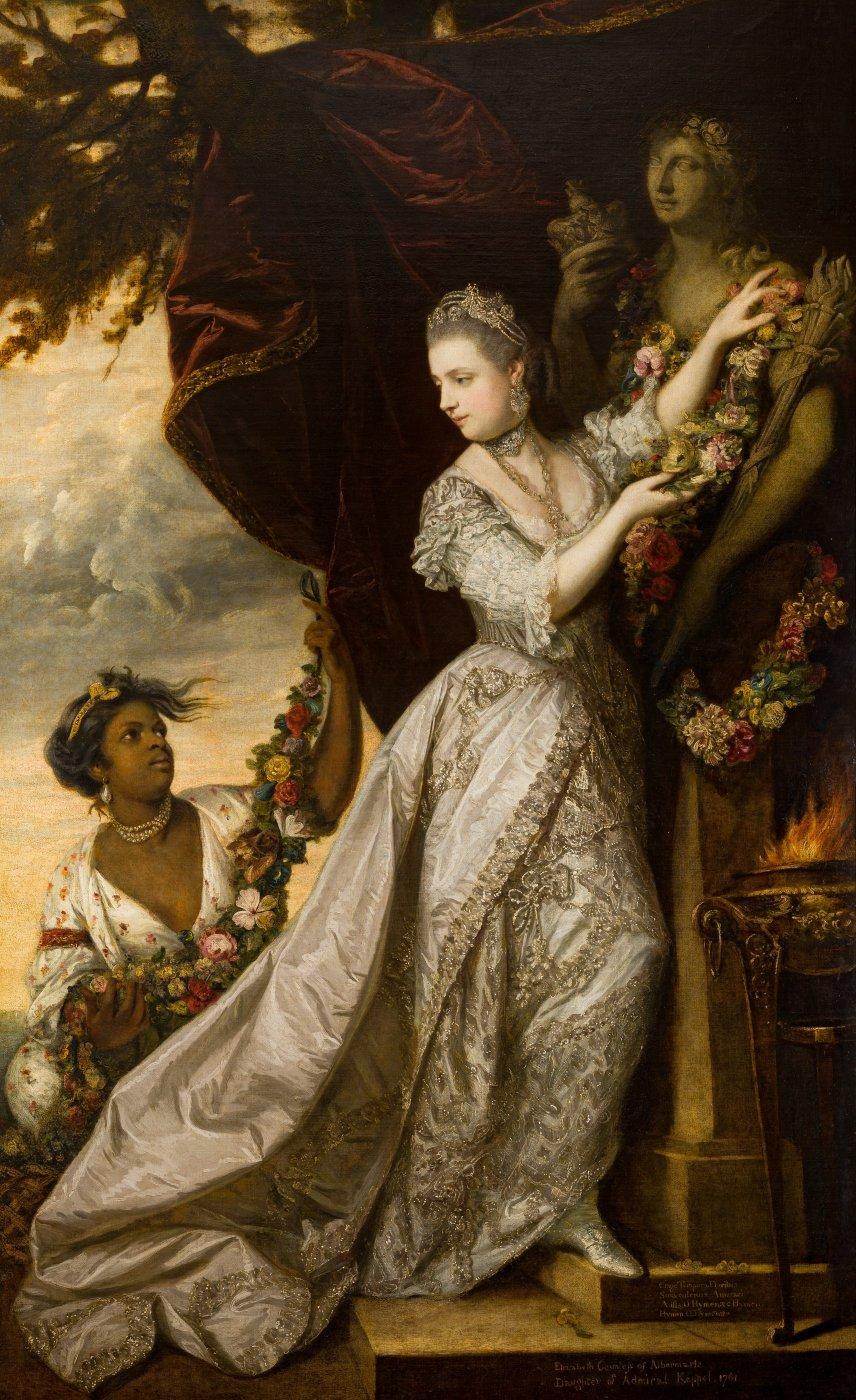The story of Joshua Reynolds and Art Fund

On the 300th anniversary of Joshua Reynolds' birth, Paul McQueen explores Art Fund’s history of supporting UK museums and galleries to collect works by the 18th-century portrait painter, and the important questions about our histories they continue to help us ask.
A version of this article first appeared in the summer 2023 issue of Art Quarterly, the magazine of Art Fund.
On 10 July 1776 a story in the Morning Chronicle and London Advertiser reported the reaction of Native American leader Thayendanegea, also known as Joseph Brant, to Joshua Reynolds’ recently painted Portrait of Mai (Omai) – already much discussed since its display at the Royal Academy that spring. Brant, who had sailed to England the previous November to reaffirm Iroquois alliances to Britain as the American Revolution intensified (the Founding Fathers signed the Declaration of Independence on 4 July 1776), apparently pondered whether the sitter was a mighty chief, come to exact payment from George III for joining the battle against the revolutionary Americans, or a conquered subject, mockingly paraded in womanly attire. Brant was allegedly also astonished to learn that not one of this tattooed young man’s countrymen – inhabitants of a remote and unimportant island – had fallen in His Majesty’s service. Brant’s remarks, very likely a fabrication, today tell us more about urban anxieties in Georgian Britain concerning the turbulent state of the empire, not to mention colonial violence and attitudes towards race and gender, than they do about the actual sitter or Reynolds’ painting of him; but what they do reveal is that, for as long as people have been looking at Portrait of Mai (Omai), they have been talking about it and attempting to understand its immense importance in reflecting a period of profound change.

‘It is perhaps the greatest work of Britain’s greatest portraitist and the first-ever grand portrait of a non-white subject,’ wrote a group of eminent historians in a joint letter to the Financial Times last June, as a campaign got underway to prevent the painting, in private ownership and export stopped, from being sold abroad. ‘The story of Mai is now of more interest than ever as we seek to examine our past and understand who we are as a nation.’ Mai is the real name of the sitter, the first Pacific Islander to visit Britain – the ‘O’ derives from the misinterpretation at the time of a Tahitian term of introduction – who arrived in 1774 on the Adventure, having joined Captain James Cook’s second voyage, and stayed two years, becoming a Georgian celebrity.
In late April, following an extension to the original export-stop date of 10 March, it was announced that funds had been raised to enable the National Portrait Gallery (NPG) in London and the J Paul Getty Museum in Los Angeles in the US to jointly acquire the work at its £50 million valuation. The National Heritage Memorial Fund gave £10 million, Art Fund gave £2.5 million – the largest grant in its 120-year history – and many trusts, foundations and individuals, including more than 2,000 Art Fund members and supporters, donated generously to ensure the work will now be on public view in perpetuity. Portrait of Mai (Omai) will be on display at the NPG when it reopens after its three-year refurbishment on 22 June.
Over the years Art Fund has helped 26 UK museums, galleries and historic houses to collect 34 works by Reynolds, through gifts, bequests and acquisition grants, often when faced with the threat of their loss overseas. Colonel Acland and Lord Sydney: The Archers (1769) counts among the finest. Tate acquired it through export stop for £3.2 million, supported by a £400,000 grant from Art Fund, in 2005. Both The Archers and Portrait of Mai (Omai) were then on display at Tate Britain, the centrepieces of the exhibition ‘Joshua Reynolds: The Creation of Celebrity’, which traced the artist’s ascent from a relatively humble start to the pinnacle of Georgian society.
Reynolds was born in Plympton, five miles from Plymouth in Devon, on 16 July 1723, the son of a schoolmaster and clergyman. He was apprenticed at 17 to the portrait painter Thomas Hudson, who introduced him to London’s elite, and returned home in around 1743, setting up his first studio close to the Royal Navy dockyards, where he took advantage of the affluence flowing into the West Country from around the globe. In 1749 he set off on a two-year tour of Italy, where he encountered art that would transform his thinking and career.
Thereafter he settled in London and soon became the go-to portraitist for soldiers, politicians, actors, courtesans, intellectuals and aristocrats – everyone who was anyone. The newly formed Royal Academy elected him as its first president in 1768, a position he held until his death in 1792, and his knighthood in 1769 cemented his place in the establishment. Between then and 1790, he delivered a series of lectures to RA students, published as Discourses on Art, in which he argued that artists should idealise rather than copy nature, and incorporate references to Classical and Old Master works when depicting their subjects, thereby elevating portraiture to the status of history painting.
The Archers, in which Reynolds draws on Titian’s poesie paintings, especially Death of Actaeon (c1559-75) at the National Gallery, London, exemplifies his theories. In quasi-historical dress Acland, a politician and soldier, who fought in the war against the American colonists, and Sydney, a diplomat, lope through the woods, leaving a trail of deer and game behind them, arrows flexed in their bows. ‘The universal appeal of the subject is ideal for Tate’s interpretation and education programmes,’ writes Reynolds expert Martin Postle, when recording the acquisition details for Art Fund, ‘and provides an exciting entry point for a deeper investigation of 18th-century British art and culture. As one illustration of the point, in his 2019 essay ‘How art changed my life‘ for Tate Etc, Raphael Oyelade, a maths and physics tutor, describes how participating in a summer project for GCSE art students which explored The Archers transformed his view of museums.
When the NPG reopens visitors will be able to engage with five of the six portraits previously acquired with Art Fund support, which take them to the heart of Reynolds’ world. The first, James Macardell (c1756-60), his engraver (not on show), arrived in 1942, followed in 1958 by John Stuart, 3rd Earl of Bute (1773), the seventh prime minister, whose taxation policies angered the American colonies. In 1965 an 11th-hour government grant enabled the gallery to acquire James Boswell (1785), who dedicated his biography Life of Samuel Johnson (1791) to Reynolds.
Laurence Sterne (1760) joined the collection in 1975 after an anonymous donor bridged the funding gap. Reynolds painted Sterne following the publication of the first two volumes of The Life and Opinions of Tristram Shandy, Gentleman, refusing payment, possibly out of admiration for London’s newest literary star, possibly suspecting the money he would make from the associated engraving. After Sterne’s death in 1768, his body was stolen by grave robbers and sold to the professor of anatomy at Cambridge. Testament to the success of the engraving, a student recognised him on the operating table.
The NPG acquired Horace Walpole (c1756-57) in 1999. Walpole, who wrote the first history of English art and the Gothic novel The Castle of Otranto (1764), reportedly seized Macardell’s copper engraving plate and added the inscription ‘youngest son of prime minister Sir Robert Walpole, Earl of Orford’, lest he be identified as a common writer.
Sir Joseph Banks, Bt (1773), acquired in 1986, depicts a figure intimately associated with Mai’s story. Banks was a respected and extremely wealthy botanist, who accompanied Cook on his first voyage. Reynolds has him half-rising from his desk, as if responding to the Horatian quotation scribbled on his scattered papers: Cras ingens iterabimus aequor (tomorrow we’ll sail the vast deep again). Banks hosted Mai at his Mayfair home and acted as his sponsor. They appear together, along with Swedish scientist Daniel Solander, another Cook alumnus, in William Parry’s group portrait, jointly acquired by the NPG, the Captain Cook Memorial Museum, Whitby, and Amgueddfa Cymru – Museum Wales, in 2003, also with Art Fund support.
Five years earlier Art Fund helped Amgueddfa Cymru – Museum Wales to acquire Charlotte Grenville, Wife of Sir Watkin Williams Wynn, and Her Children (c1777-79) for £1.25 million. The eldest daughter of George Grenville, the eighth prime minister, whose taxation policies further alienated the American colonies, Grenville and her husband rank among the greatest art patrons in Welsh history. Reynolds paints her in the kind of costume popularised by Lady Mary Wortley Montagu, who travelled through the Ottoman Empire between 1716 and 1718, and her children resemble those in Titian’s The Vendramin Family (c1540-45) at the National Gallery. ‘After 200 years in a Welsh private collection, its loss abroad would have been a calamity,’ Mark Evans, the museum’s then assistant keeper, writes in a letter of thanks to Art Fund.
In 2022 poet and researcher Rachel Carney ran workshops at the museum, inviting local people to respond to its 18th-century collection. Recordings of three poems inspired by Charlotte Grenville feature in the online exhibition ‘In So Many Words’.
‘Sir Joshua has begun a charming picture of my three fair nieces,’ Walpole wrote to the poet William Mason on 20 May 1780. ‘I rather wished to have them drawn like the Graces adorning a bust of the Duchess as the Magna Mater; but my ideas are not adopted.’ Regardless, The Ladies Waldegrave made headlines across the country when the National Galleries of Scotland acquired it in 1952. Between 2014 and 2015 it went on loan to the Frick Collection in New York for ‘Masterpieces from the Scottish National Gallery’.

Four decades on, in 1992, Art Fund helped National Galleries of Scotland acquire John Murray, 4th Earl of Dunmore (1765), which had been on loan since 1938. Murray, whom Reynolds depicts in clan tartan, was a politician and soldier whose actions precipitated the American War of Independence, and his portrait had long been an important part of the gallery’s series of Highland chieftains. It can currently be seen in the free display ‘The Remaking of Scotland: Nation, Migration, Globalisation 1760-1860’ at the Scottish National Portrait Gallery. The show provides insights into a complex and often challenging phase of Scottish and world history.
As in Scotland, the wealth passing through the port of Plymouth in the 18th century, and accumulating in surrounding country estates, was the result of a massive expansion in global trade, and part of that trade was connected to transatlantic slavery. This understanding is central to the exhibition ‘Reframing Reynolds: A Celebration’ at the Box, Plymouth, from 24 June to 29 October, which focuses on his early career in Devon and his Italian tour.
‘Reynolds was obviously a brilliant artist and businessman, but we have to think about what ingredients made it possible for all these local people to have their portraits painted,’ says Victoria Pomery, CEO of the Box. ‘We have to interrogate the art history we have tended to accept, and say, “Well, what is really going on here? Why do we think that? How have we always thought that?”’
To start to answer these questions the Box is amplifying its 18 works by Reynolds, the largest UK public collection outside London, with loans made through the Weston Loan Programme with Art Fund, established with the Garfield Weston Foundation in 2017 to provide museums across the UK with the means to borrow significant works of art from national collections. Pomery describes its many loan requests as ‘ambitious’, with highlights including the newly conserved The Hon Theresa Robinson, Mrs John Parker (1770-72) from Saltram, a National Trust property in Plympton, and the pairing of Lady Elizabeth Keppel (1761) from Woburn Abbey with Captain the Honourable Augustus Keppel (1752-53) from the National Maritime Museum, London. The woman who accompanies Lady Keppel had two independent morning sittings in December 1961, after Reynolds had painted the central figure; however, his logbook records no name, only the single word ‘negro’. Loans confirmed to date will come from the Barber Institute of Fine Arts, Birmingham, and Tate, with more planned.

Two items from the Box collection acquired with Art Fund support in 2014 – Self-Portrait (1746) and Reynolds’ sketchbook from 1750 to 1752, which contains 121 drawings of Old Masters – will be juxtaposed with work by contemporary artist and Royal Academician Rana Begum, to explore Reynolds’ legacy today. Watercolours made during Begum’s own travels will be shown alongside Reynolds’ sketches, highlighting links between their practices, and Begum will create two new works in response to Self-Portrait and another painting, drawing out their mutual fascination with colour and light. ‘We knew we wanted to work with a contemporary artist, and, interestingly, Rana has been massively taken with Reynolds,’ says Pomery. ‘It will undoubtedly create some different conversations – maybe even some we hadn’t expected.’
On 12 July 1776 the Resolution sailed from Plymouth with the stated aim of returning Mai to his homeland; we now know that Cook had in fact received instructions to search for a passage from the Pacific to the North Atlantic, a potentially lucrative trade route for Britain. That Reynolds’ Portrait of Mai (Omai) has kept us thinking about what we believe we know about this period of history is just one example of how important art is, and why we need great works from the past by artists such as Reynolds to remain on public view: they invite us to keep looking, keep talking and keep asking questions.
’Reframing Reynolds: A Celebration’, the Box, Plymouth, 24 June to 29 October 2023.
Find out more about the acquisition of Portrait of Mai (Omai).